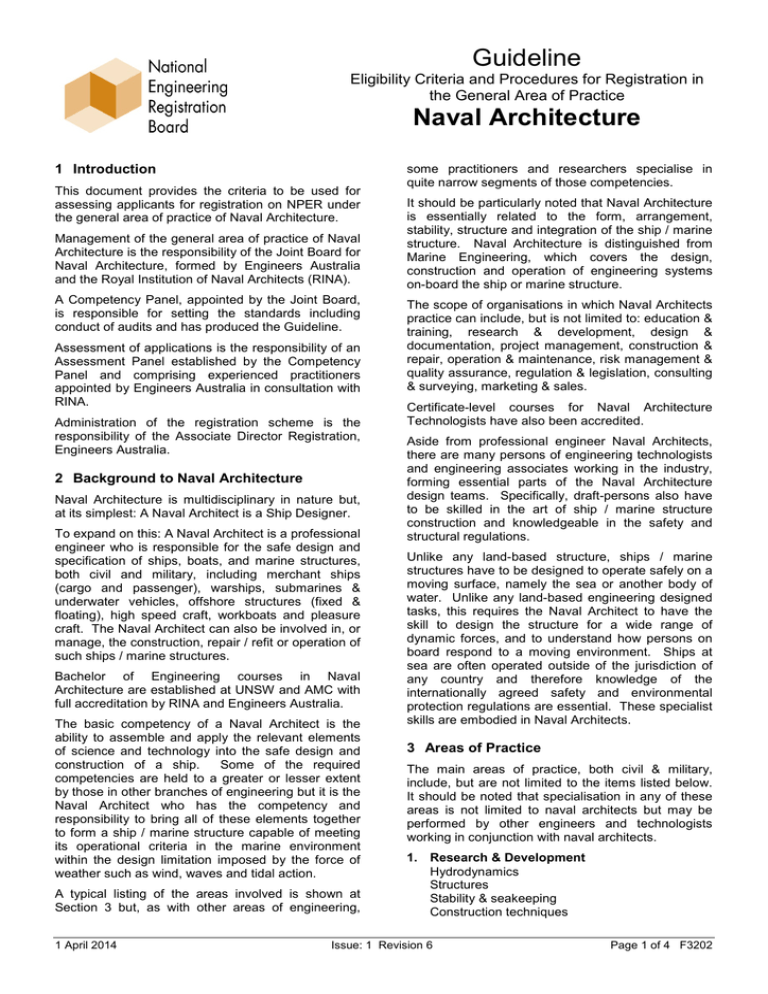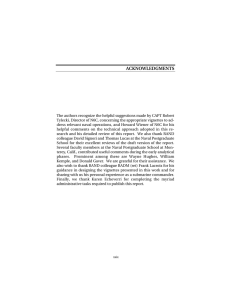Naval Architecture - Engineers Australia
advertisement

Guideline Eligibility Criteria and Procedures for Registration in the General Area of Practice Naval Architecture 1 Introduction This document provides the criteria to be used for assessing applicants for registration on NPER under the general area of practice of Naval Architecture. Management of the general area of practice of Naval Architecture is the responsibility of the Joint Board for Naval Architecture, formed by Engineers Australia and the Royal Institution of Naval Architects (RINA). A Competency Panel, appointed by the Joint Board, is responsible for setting the standards including conduct of audits and has produced the Guideline. Assessment of applications is the responsibility of an Assessment Panel established by the Competency Panel and comprising experienced practitioners appointed by Engineers Australia in consultation with RINA. Administration of the registration scheme is the responsibility of the Associate Director Registration, Engineers Australia. 2 Background to Naval Architecture Naval Architecture is multidisciplinary in nature but, at its simplest: A Naval Architect is a Ship Designer. To expand on this: A Naval Architect is a professional engineer who is responsible for the safe design and specification of ships, boats, and marine structures, both civil and military, including merchant ships (cargo and passenger), warships, submarines & underwater vehicles, offshore structures (fixed & floating), high speed craft, workboats and pleasure craft. The Naval Architect can also be involved in, or manage, the construction, repair / refit or operation of such ships / marine structures. Bachelor of Engineering courses in Naval Architecture are established at UNSW and AMC with full accreditation by RINA and Engineers Australia. The basic competency of a Naval Architect is the ability to assemble and apply the relevant elements of science and technology into the safe design and construction of a ship. Some of the required competencies are held to a greater or lesser extent by those in other branches of engineering but it is the Naval Architect who has the competency and responsibility to bring all of these elements together to form a ship / marine structure capable of meeting its operational criteria in the marine environment within the design limitation imposed by the force of weather such as wind, waves and tidal action. A typical listing of the areas involved is shown at Section 3 but, as with other areas of engineering, 1 April 2014 some practitioners and researchers specialise in quite narrow segments of those competencies. It should be particularly noted that Naval Architecture is essentially related to the form, arrangement, stability, structure and integration of the ship / marine structure. Naval Architecture is distinguished from Marine Engineering, which covers the design, construction and operation of engineering systems on-board the ship or marine structure. The scope of organisations in which Naval Architects practice can include, but is not limited to: education & training, research & development, design & documentation, project management, construction & repair, operation & maintenance, risk management & quality assurance, regulation & legislation, consulting & surveying, marketing & sales. Certificate-level courses for Naval Architecture Technologists have also been accredited. Aside from professional engineer Naval Architects, there are many persons of engineering technologists and engineering associates working in the industry, forming essential parts of the Naval Architecture design teams. Specifically, draft-persons also have to be skilled in the art of ship / marine structure construction and knowledgeable in the safety and structural regulations. Unlike any land-based structure, ships / marine structures have to be designed to operate safely on a moving surface, namely the sea or another body of water. Unlike any land-based engineering designed tasks, this requires the Naval Architect to have the skill to design the structure for a wide range of dynamic forces, and to understand how persons on board respond to a moving environment. Ships at sea are often operated outside of the jurisdiction of any country and therefore knowledge of the internationally agreed safety and environmental protection regulations are essential. These specialist skills are embodied in Naval Architects. 3 Areas of Practice The main areas of practice, both civil & military, include, but are not limited to the items listed below. It should be noted that specialisation in any of these areas is not limited to naval architects but may be performed by other engineers and technologists working in conjunction with naval architects. 1. Research & Development Hydrodynamics Structures Stability & seakeeping Construction techniques Issue: 1 Revision 6 Page 1 of 4 F3202 Production processes Materials science Novel craft Docking and slipping operations 2. Design & Documentation Vessel specifications Contract preparation & management Site supervision Test bed trials Sea trials & vessel acceptance Statutory & class requirements Simulation and model testing Hydrodynamics, resistance & propulsion Hydrostatics & stability (intact and damaged) Freeboard and subdivision Ship motions, seakeeping & controllability Steering and manoeuvrability Structures & loading (global & local) Vessel arrangement (overall & compartments) Power plant and machinery systems Deck machinery & cargo handling Ballast, services and cargo piping systems Vibration & acoustics Heating, ventilation, airconditioning & refrigeration systems Preservation and corrosion control systems Lifesaving & safety equipment & systems Fire protection, detection & fire fighting equipment & systems Electrical & electronic systems Communication and navigation systems Specialist payload systems (military, fishing, offshore, etc) Pollution prevention equipment & systems Environmental protection 3. Production Build strategy development and implementation Production scheduling & production control Quality assurance & quality control Materials management Fabrication & assembly processes Hull construction Launching calculations and practices Docking and undocking calculations and practices Production management Corrosion control systems (active & passive) Painting & protection Outfitting processes Commissioning & sea trials Shipyard layout, machinery and production facilities 4. Operation, Repair and Maintenance Cargo loading & stability Maintenance management (planned, preventive, condition monitoring) Safety & security management Refitting and refurbishment Preservation and corrosion control in service Life cycle management & recycling Environmental management Operational economics & management 1 April 2014 5. Risk Management Business continuity management Governance & due diligence Safety & environmental 6. Regulatory, Consulting & Surveying Flag state implementation of international regulations Classification society surveys (exclusive & nonexclusive) Government surveys (international, national, local, port state) Salvage association & insurance surveys Condition surveys & assessment Legislation development and compliance monitoring Design approvals Site inspection Inter-governmental relations International conventions Environmental management Safety & security management 7. Education & Training Knowledge and skills development in the areas described in 1 to 6 above 8. Marketing & Sales Design and product development to meet client needs 4 Eligibility Requirements for Registration Applicants must possess an academic qualification (e.g. a four year engineering degree) accredited or recognised by Engineers Australia, or equivalent overseas qualification. They must also be able to satisfy the Australian Engineering Competency Standards for Professional Engineers Stage 2 for Professional Engineer. In addition to their qualifications and experience, applicants will need to demonstrate: • That Naval Architecture is a significant part of their professional employment or practice; and • That they practise independently or under general direction as naval architects in at least one of the areas of practice listed in Section 3 above. 5 The Application and Assessment Process 5.1 Making an Application The following sections indicate what you must do to register on NPER in the general area of practice of Naval Architecture Engineering or to apply for assessment of qualifications and competencies as an RPEQ under the Professional Engineers Act 2002 (QLD). Issue: 1 Revision 6 Page 2 of 4 F3202 You do not need to join Engineers Australia to register on NPER/NETR/NEAR and/or to apply for RPEQ. If you choose not to join Engineers Australia, you must complete a Registration Applicant’s Declaration at the bottom of the webpage http://www.engineersaustralia.org.au/nerb/profession al-engineers. 5.2 Required Documents You must complete the supplementary form attached to this Guideline, in addition to your Application for Registration. If you are a CEng (UK) MRINA or a Chartered Member of RINA, you may apply for registration on NPER – Naval Architecture using the Mutual Recognition Agreement application form. This form can be downloaded from the Engineers Australia website and explains the required documents for application. The form will also enable you to obtain Chartered Status (CPEng) if you wish. If you do not wish to gain Chartered Status at the same time, please mark on the form that you only require NPER registration. If you are a Chartered Member of Engineers Australia (CPEng), you may apply for registration on NPER – Naval Architecture using the Application for Registration on NPER (www.nerb.org.au > applying). You may also apply for assessment for RPEQ using the Application for Assessment. In either case, you must submit a Statement of Experience and evidence of how you have kept up-to-date in your practice (CPD record), as explained on the application form. If your academic qualification is in a field other than Naval Architecture, you must show in your Statement of Experience and your record of continuing professional development (CPD) that you have received adequate formation in the discipline of Naval Architecture. If you are not included in the two groups above, you must progress through a Stage 2 Competency Assessment to satisfy the 2012 Australian Engineering Competency Standards Stage 2 for your occupational category via the eChartered portal online at www.engineersaustralia.org.au/echartered even if you do not intend to join Engineers Australia. All applications are submitted electronically using the eChartered electronic system. The same process will also allow you to obtain Chartered Status if you wish. For becoming Chartered, you must join Engineers Australia prior to commencing the process on eChartered. by Naval Architecture, and show that they meet the requirements described in this Guideline. Your documents must be reviewed and substantiated by an experienced professional engineer as being a true representation of your recent responsibilities. 5.3 Assessment If you are a CEng MRINA, or a Chartered Member of RINA, you will be registered on NPER – Naval Architecture on confirmation that you are a Chartered Member of the Royal Institution of Naval Architects and are registered as a Chartered Engineer. Your Statement of Experience and CPD record will be assessed for currency against the requirements for Naval Architecture set out in Section 3 of this Guideline. If you are a Chartered Member of Engineers Australia (CPEng), your Statement of Experience and record of continuing professional development (CPD) will be reviewed by an Assessor for evidence that you meet the requirements for Naval Architecture (see Section 4 above). You may be invited to attend a Professional Interview with an Assessment Panel established by the relevant Colleges/Society. If you are not a Chartered Member of Engineers Australia (CPEng) nor covered by an MRA, you will be assessed through eChartered. When your eChartered submission is approved, you will attend a Professional Interview lasting about one hour as explained in the Online Participant’s Guide on the eChartered portal at www.engineersaustralia.org.au/echartered. Any questions on the eChartered process or associated pathways should be directed to the eChartered Team. Your application for recognition in the general area of practice of Naval Architecture, together with appropriate attachments and fees, must be forwarded to: Associate Director Registration, Engineers Australia, 11 National Circuit, Barton ACT 2600 If you are a Corporate Member of RINA but not CEng(UK), you should take the matter up with Secretary of RINA Australian Division (email to rina.austdiv@optusnet.com.au or mail to PO Box 462, Jamison Centre, ACT 2614). All applicants must provide clear evidence that they have worked competently in areas covered 1 April 2014 Issue: 1 Revision 6 Page 3 of 4 F3202 SUPPLEMENTARY FORM FOR AN APPLICATION FOR REGISTRATION IN NPER – NAVAL ARCHITECTURE Applicant’s Name ……………………………………… Membership/Registration No. If already registered on NPER in another area of practice or if applying for NPER – Naval Architecture as your first general area of practice, attach this form to a form for an Application for Registration on NPER. Chartered Members of the Royal Institution of Naval Architects must provide Membership No If applying concurrently for Chartered Professional Engineer (CPEng), submit this form at the time of Professional Interview. A1. Demonstrated Responsibility in Naval Architecture I have provided professional services independently, or under general direction, in Naval Architecture in the following positions: ……………………………………………………………………………………………………………………… …………………………………………………………………………………………………………………..….. ………………………………………………………………………………………………………………..…….. …………………………………………………………………………………………………………………..….. …………………………………………………………………………………………………………………..….. ………………………………………………………………………………………………………………..…….. Please provide, in your Statement of Experience, details of these positions, stating the functions you performed and the responsibilities you accepted. (If necessary, attach a separate summary sheet for A1.) A2. Professional Practice in Naval Architecture You must demonstrate that you practise in at least one of the areas in Section 3. In summary of your application, please indicate your professional involvement in one or more of the following. Please √. Research and Development Design and Documentation Production Operation, Repair, Maintenance Risk Management Education and Training Regulation, Consulting, Surveying Marketing and Sales Other (specify below) If you have ticked ‘other’ in the table above, please describe the Naval Architecture areas below. …………………………………………………………………………………………………………………………………… …………………………………………………………………………………………………………………………………… …………………………………………………………………………………………………………………………………… This summary of my involvement in Naval Architecture and the details reported in my Statement of Experience and other supporting documents are correct. Signed ……………………………………………………………………………. 1 April 2014 Issue: 1 Revision 6 Date ……/……/……….. Page 4 of 4 F3202


